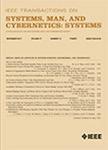版权所有:内蒙古大学图书馆 技术提供:维普资讯• 智图
内蒙古自治区呼和浩特市赛罕区大学西街235号 邮编: 010021

作者机构:Chinese Acad Sci State Key Lab Management & Control Complex Syst Inst Automat Beijing 100190 Peoples R China
出 版 物:《IEEE TRANSACTIONS ON SYSTEMS MAN CYBERNETICS-SYSTEMS》 (IEEE Trans. Syst. Man Cybern. Syst.)
年 卷 期:2016年第46卷第7期
页 面:980-992页
核心收录:
学科分类:0808[工学-电气工程] 08[工学] 0811[工学-控制科学与工程] 0812[工学-计算机科学与技术(可授工学、理学学位)]
基 金:National Natural Science Foundation of China [61225017, 61533016, 61421004, 61422310] Strategic Priority Research Program of the Chinese Academy of Sciences (CAS) [XDB02080004] CAS
主 题:Friction model lower limb rehabilitation robot (LLRR) motion intention recognition optimization of exciting trajectories recursive optimization
摘 要:In order to implement model-based recognition of human motion intention, dynamics modeling and identification of a lower limb rehabilitation robot named iLeg is investigated. Due to the relatively strong motion constraints, the traditional identification methods become insufficient for iLeg in three aspects: 1) the coupling factors among joints have not been considered in the traditional joint friction models, which makes the structural error and the torque estimation errors relatively large;2) because of the small and complicated feasible region caused by the motion constraints, the traditional initialization strategy, for searching the valid initial solutions of the optimization problem for the exciting trajectories, becomes very inefficient;and 3) the condition number of the observation matrix, calculated from the preliminary dynamic model and the associated optimized exciting trajectory, is too large for the identification, and, however, further reduction of the condition number has not been considered in the literature. Therefore, corresponding contributions are presented to overcome the limitation. First, the coupling factors among joints are considered in the joint friction model by using the Palmgren empirical formulation and a polynomial fitting method. Then, an indirectly generating strategy is designed, by which the valid initial solutions of the optimization problem can be found with good efficiency. Moreover, a recursive optimization method based on the optimization of the dynamic model and the exciting trajectories, is proposed to further reduce the condition number. Finally, the performance of the proposed methods is demonstrated by several experiments.